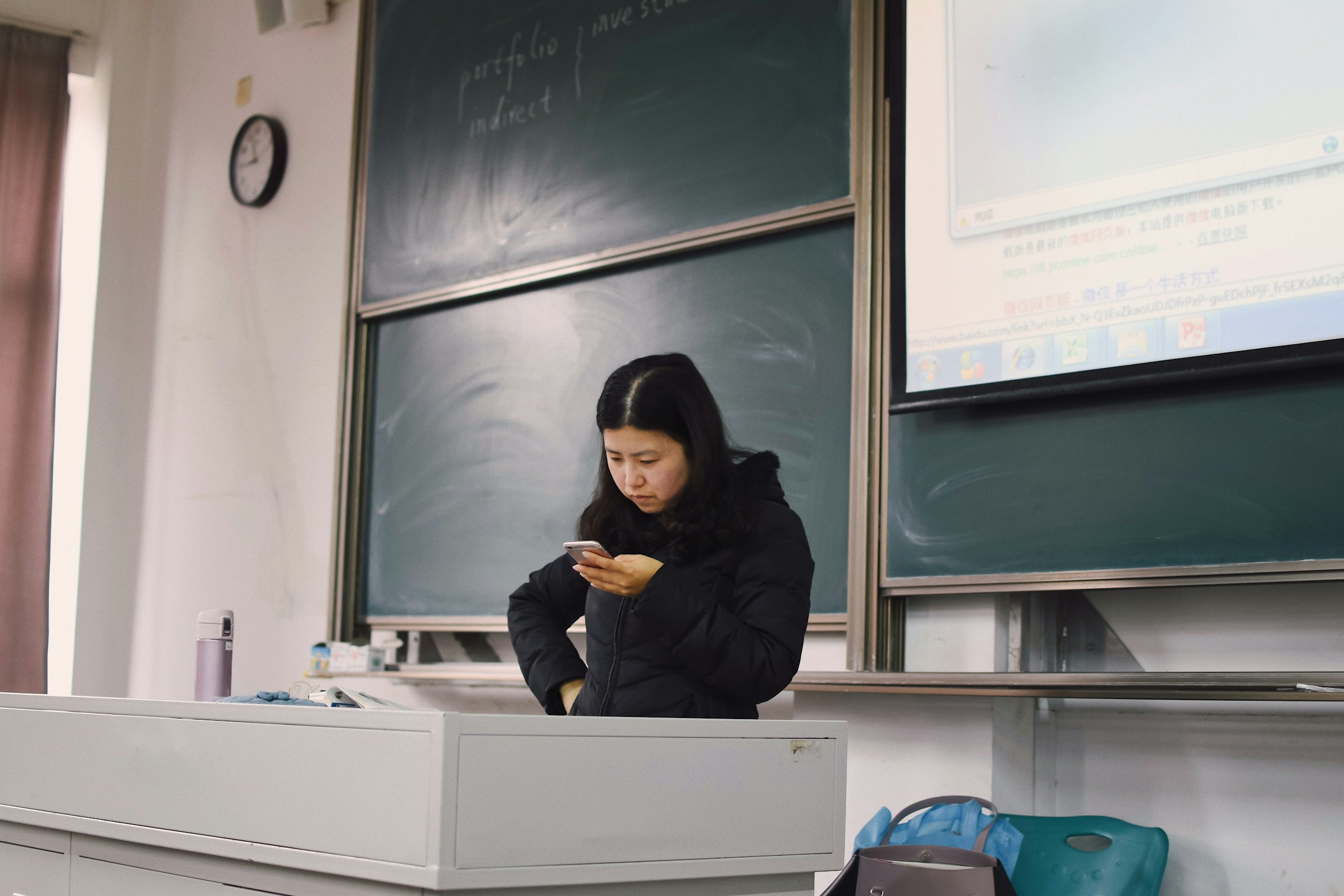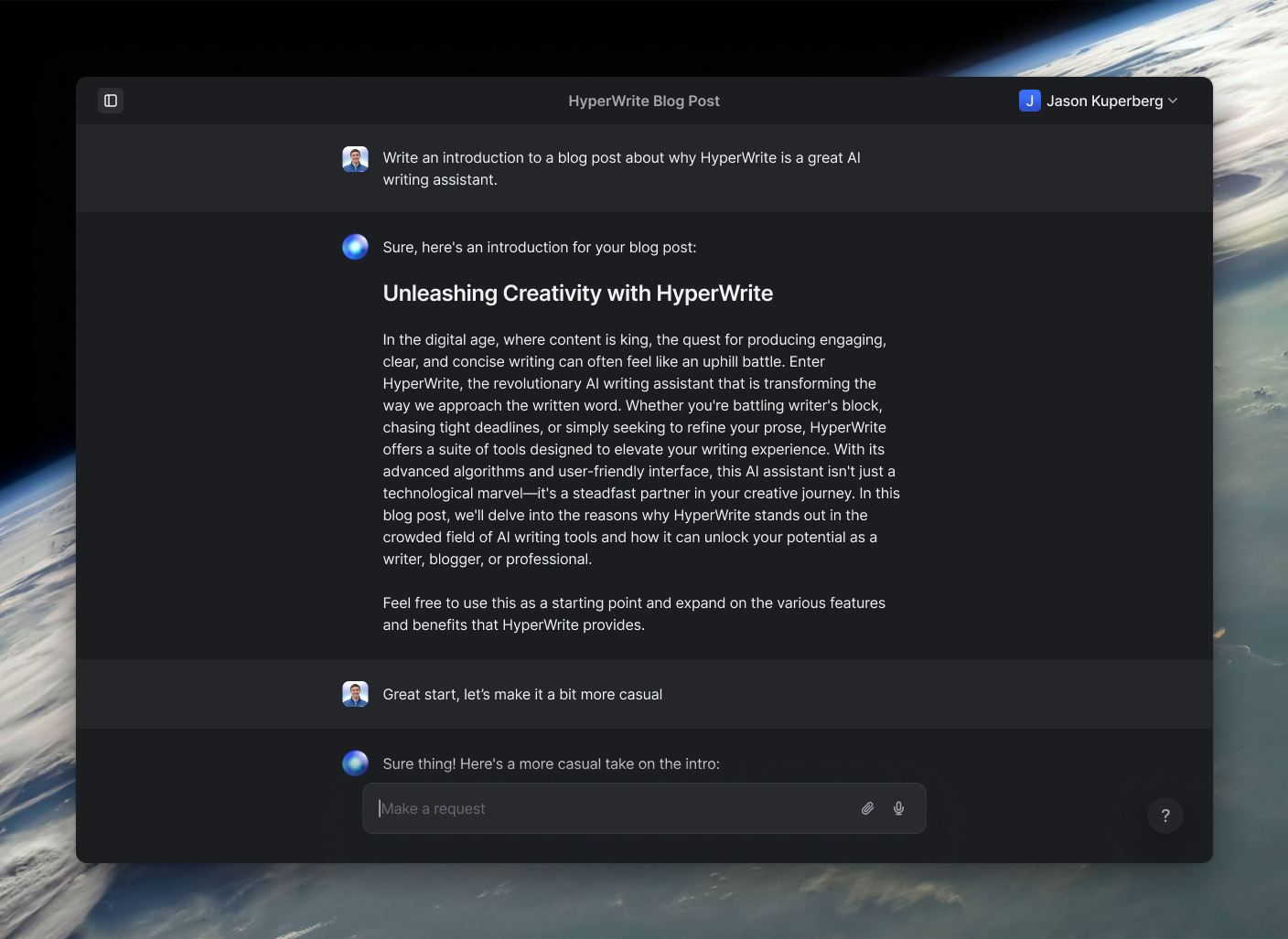
Students today face immense pressure to perform well academically. They juggle assignments, tests, and extracurricular commitments. They’re expected to learn and adapt to an increasingly digital world. With all these competing priorities, it's no wonder that so many students feel overwhelmed and stressed. Thankfully, artificial intelligence has entered the chat. In this blog, we’ll explore Best AI Tools For Students, why is AI good for students to help you harness the power of AI for academic success. You'll discover how AI can help students learn faster, think more critically, and succeed academically, while staying ethical, responsible, and future-ready.
One key AI tool that can help you achieve these goals is HyperWrite, an AI writing assistant. HyperWrite can help students brainstorm ideas, create outlines, and generate text to help them get started on writing assignments. This can help reduce stress and improve academic performance.
Why Is AI Good For Students?
.jpg)
Purdue professors Andrés Bejarano and Daniel Guberman have spent the past two years navigating the growing presence of artificial intelligence (AI) in their classrooms. While they hold different views on how AI should be used in education, they agree on one point: AI is here to stay, and students must learn to use it responsibly.
Cutting Through the Noise: How AI Streamlines Student Research
Bejarano, a professor of computer science, compares AI to a more powerful search engine.
“AI is just putting together the best of the internet,” he explains. “When we use Google, we might scan the first few pages. AI filters and delivers relevant information immediately.”
This efficiency is especially valuable in fast-paced academic environments, enabling students to access useful content without having to sift through numerous sources.
AI for Structure, Not Solutions: Helping Students Navigate Coursework
Guberman, an instructional expert at Purdue’s Center for Instructional Excellence, highlights AI’s ability to support students in the early stages of research and time management.
“One of the hardest parts is picking what to explore,” he says. He encourages students to use AI tools like ChatGPT to generate ideas and organise their workload.
While AI may not solve complex assignments, it helps students manage their time more effectively and reduce stress. “One student began the semester saying she’d never used AI,” Guberman shares. “By the end, she used it regularly to manage her schedule and deadlines. It didn’t solve her engineering problems, but it did improve her organisation.”
Why Critical Thinking Still Matters in the Age of AI
In his History of Rock and Roll course, Guberman allows for the use of AI for preliminary research, though with caution.
“I asked ChatGPT about the history of Black Sabbath. Most of it was correct, but it incorrectly claimed that Ozzy Osbourne rejoined the band in the early '80s; he launched his solo career at that time. That kind of error can easily mislead students who aren’t familiar with the subject.”
Avoiding Over-Reliance: Teaching Students When Not to Use AI
Bejarano has also seen the risks of over-reliance. “AI can become addictive,” he warns. “Once students experience the convenience, especially with the basics, it’s tempting to skip independent problem-solving. But that bypasses the critical thinking skills they need to build.”
In response, Bejarano and his co-instructor, Ethan Dickey, created “AI Lab,” an initiative now embedded in several computer science courses. It introduces students to both the potential and the limits of AI in academic work. “We believe AI belongs in education, just not all the time,” Dickey notes. “It should be a tool, not a crutch.”
Teaching in the Age of AI: Support, Not Substitution
They’re also exploring how AI can support educators. Working with undergraduate researchers, they’ve developed “Boiler TA AI,” an AI tool designed to answer student questions in online discussion forums, lightening the workload on human teaching assistants.
Some students are more concerned about learning support than about long-term job security. Bejarano acknowledges that fear, especially among students in fields vulnerable to automation, is a significant concern.
“AI can write code,” he says, “but it can’t replace human creativity.” Despite the challenges, both Bejarano and Guberman agree that AI, when used thoughtfully, has real value in education. “These tools are fascinating,” Guberman says. “We may not fully understand how they work yet, but we know they’ll only become more central to our lives.”
Why Is AI Good for Students?
AI’s growing role in education is already benefiting students in meaningful ways. From improving academic performance to enhancing accessibility, here are the key advantages of artificial intelligence for learners:
1. Personalized Learning
AI tailors content to match each student's:
- Abilities
- Preferences
- Pace
Whether offering adaptive quizzes or curated reading materials, it supports individual progress more effectively than one-size-fits-all methods.
2. Real-Time Feedback
AI systems can instantly analyse answers and provide detailed feedback, helping students correct mistakes and learn more efficiently.
3. Accessibility
AI tools are enhancing learning experiences, thereby ensuring equal access to education for students with disabilities by utilizing:
- Voice input
- Speech-to-text features
- Subtitles
- Screen readers
4. Time Management
AI-powered planners help students organize their workloads, prioritize tasks, and stay on top of assignments, which is crucial for balancing academics and personal life.
5. 24/7 Learning Support
Virtual tutors and AI-based learning platforms provide round-the-clock assistance, allowing students to learn at their convenience, whenever and wherever suits them best.
6. Critical Thinking Development
Engaging simulations and adaptive learning tasks challenge students to apply their knowledge rather than merely memorize facts, fostering a deeper understanding and promoting analytical thinking.
7. Motivation and Engagement
Gamified elements and personalised feedback keep students engaged and motivated, making the learning process more interactive and enjoyable.
8. Career Readiness
By using advanced tools and simulations, students develop skills that prepare them for tech-driven workplaces, including:
- Data analysis
- Digital communication
- Self-directed learning
AI in Personalized Learning
Customized learning paths, powered by AI, enable students to progress based on their unique strengths and weaknesses. AI can assess performance data in real-time, suggest targeted resources, and adjust teaching strategies accordingly, helping students master content more quickly and with greater confidence.
AI in the Classroom
Educators are also benefiting from the integration of AI.
It’s transforming how classrooms function by:
- Automating assessments gives teachers more time for interaction.
- Using virtual tutors to support students outside class hours.
- Recognising students’ emotional and cognitive states to guide instruction.
- Promoting inclusive learning through adaptive content and accessibility features.
- Helping students plan their schedules, track deadlines, and optimize productivity.
AI and Inclusive Education
AI also plays a critical role in improving access to education for students with disabilities or language barriers:
- Speech-to-text and real-time subtitles enable communication for students who are hearing- or speech-impaired.
- AI translation tools break down language barriers for multilingual classrooms.
- Interface adaptations ensure educational tools are usable for individuals with varying physical and cognitive needs.
From Dependency to Mastery: The Right Way to Use AI in Learning
The short answer is yes, provided awareness and responsibility are present. AI is not a shortcut to learning, but a supplement to it. When used wisely, qualities essential for success in any field, it empowers students to become more:
- Independent
- Strategic
- Effective learners
Related Reading
- Should Students Use AI
- Can You Use AI For College Essays
- Essay Writing Tips For Students
- Can You Use ChatGPT For College Essays
- How Can AI Help Students
- Using AI To Write Essays
- College Essay Writing Tips
- How To Write The Best College Essay
- Essay Writing Prompts
- Benefits Of Using AI Writing Tools
- Types Of Essay Writing
Guiding Students to Assess the Merits of Artificial Intelligence Tools

Concerns about technology and its impact on student learning aren’t new. When people say that allowing students to access artificial intelligence (AI) will negatively impact their ability to learn and think, I don’t believe that to be the case.
I think it’s simply a matter of reframing how we use AI. Just as we can foster student learning with calculators, the internet, and word processing software, we can do the same with AI.
Assessing AI Performance
AI tools can generate a wide range of content, including:
- Essays
- Artwork
- Music
To utilize it as a learning tool, we need students to assess AI’s performance. We know what AI can do, but we need to ask, can AI do it well? By allowing students the opportunity to assess the products that AI generates, we can prompt their learning and their development of critical thinking skills.
AI can be used to enable students to construct knowledge, collaborate with their peers, and create new content in any area. If we can design AI tasks that foster the 3Cs, we can use them as a tool for learning and thinking.
Real-Life Applications of AI in the Classroom
The benefits of AI for students can be harnessed in real-life classroom applications. For example, here’s how AI tools can be used to promote critical thinking in:
- English
- Music
- Math classes
Prompting Deeper Thinking: AI in the English Literature Classroom
In an English classroom, students are often asked to read a text and then share their interpretation of or conclusion about the text by writing a paragraph. Once they’ve finished reading a text such as a selection from early in a novel, we can give them a prompt with a prediction question like, “In the book Of Mice and Men, will George and Lennie ever be able to achieve their dream? Support your answer by writing a paragraph and offering three reasons.”
Peer Review Meets AI: Helping Students Judge Text with Rubrics
Students can construct their yes or no answer in their mind and then ask an AI tool like ChatGPT for its answer. In groups, students should collaboratively read the ChatGPT response and assess it using the provided teacher rubric.
This will allow students to assess the quality of the AI response while also familiarizing them with the evaluation tool that the teacher will use to evaluate their work.
Teaching Rebuttal and Perspective-Taking with AI-Prompted Debate
Individually, ask students to create a paragraph that is written to defend the opposite position. For example, if ChatGPT said that George and Lennie wouldn’t be able to achieve their dream, students need to write a paragraph arguing that they would achieve their dream.
This enables students to identify the points that support the opposing opinion and then develop rebuttals that refute them. This provides students with the opportunity to gather and assess relevant information, which strengthens their critical thinking skills.
Music and AI: A Perfect Pairing
In a music appreciation classroom, a teacher can prompt learning and thinking by having students construct a list of criteria for what constitutes good music. Once this list is created, students can collaborate in groups to ask an AI tool like Soundraw to develop a piece of music that meets the specifications of good music.
Then, individually, students can confer with the teacher to share their response if they believe that the AI’s music was good, but they can also share what they would change to make the music even better. This process challenges students to identify problems and develop viable solutions, allowing them to grow as critical thinkers.
Using AI in Math Class to Promote Problem-Solving Skills
Mathematical thinking fosters students’ problem-solving skills, and AI can be used to engage students in that process. Teachers can give students a math problem that students input into an AI tool like Photomath.
Evaluating Problem-Solving Approaches Through Collaborative Comparison
Once the AI creates an answer, students can collaborate in groups to construct their own answer by using the mathematical problem-solving approach they’ve been taught. With the two answers in hand, AI’s and their own, students can create a response to the question, “Which solution is more correct?”
This allows students to test solutions to complex problems against criteria that the classroom teacher has provided through a rubric or by testing them against the process that the teacher has taught. This leads students to form a conclusion, which is another important facet of critical thinking.
Students Will Draw Their Own Conclusions
I’ve used AI tools with students on several occasions across different subject areas, and I’ve seen them complete the activities I’ve already shared.
Students have made the following comments:
- “I like it for research, but I’m not happy with the work it produces, so that I wouldn’t use it as my own.”
- “It’s a good place to start if you’re stuck and need some ideas.”
- “[AI’s] work isn’t very good and wouldn’t get me a very good grade.”
Supporting the 3Cs: How AI Can Encourage Construction, Collaboration, and Creation
Teachers are concerned about AI, with many schools banning ChatGPT and other AI tools. Educators should utilize AI as a research tool, allowing students to see that an AI-generated product is a starting point, not the finished product.
We can do this by reimagining how we use AI so that it fosters critical thinking while supporting the 3Cs of tech engagement, encouraging students to:
- Construct
- Collaborate
- Create
Related Reading
- Benefits Of AI For Students
- Steps To Writing An Essay
- Writing Prompts For Students
- Why Is My Essay Detected As AI
- Best Ways To Start An Essay
- Best AI For Medical Students
- Best AI For College Students
- Best AI Essay Writer For Students
- Free AI For Research Paper Writing
- Best AI For Essay Writing
- AI For Assignment
Try our AI Writing Assistant to Write Natural-sounding Content
Artificial intelligence tools for students are designed to improve:
- Learning outcomes
- Boost productivity
- Make education more personalized
They help students complete school assignments more quickly and effortlessly, often with less stress, and they can make learning more enjoyable.
For instance, AI writing tools can help students generate ideas for papers, create outlines, and even write full essays. Utilizing these tools can help students better comprehend the writing process and enhance their writing skills.
Write Smarter, Not Suspicious: How HyperWrite Helps Students Stay Authentic
HyperWrite pairs state-of-the-art AI with deep personalization, so every suggestion sounds like you on your best day. Students can access accurate, cited content for essays that don't sound like they were written by ChatGPT. Why is this important? Educators are recognizing that students are utilizing AI to assist with their writing.
If those essays sound like they were written by ChatGPT, it will raise a red flag. HyperWrite helps students write more effectively and expand their knowledge of a topic as they do so. And it helps them do it with a tool that won't alert their teachers.
Related Reading
- Best AI Apps For Students
- Best AI For School Work
- Best AI For Homework
- Free Grammarly Alternatives
- QuillBot Alternative
- Otter.AI Alternatives
- Jasper AI Vs ChatGPT
- ChatGPT Vs Grammarly
- SlidesGo Alternative

Powerful writing in seconds
Improve your existing writing or create high-quality content in seconds. From catchy headlines to persuasive emails, our tools are tailored to your unique needs.

